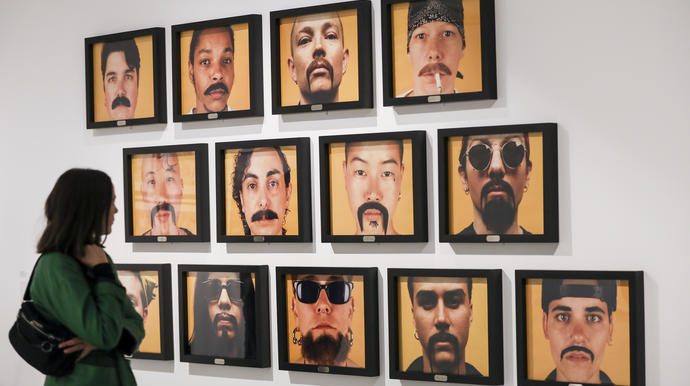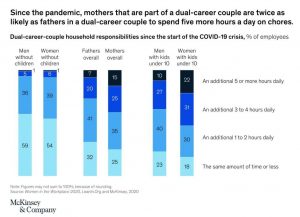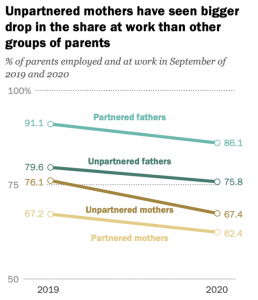by Paula Lovelock
Finding myself living in a London house-share with four guys in the mid-1990s, it only took a few weeks before I went on strike with the cleaning. I explained to them that our kitchen was becoming a health hazard and that I wasn’t prepared to work full-time and maintain basic hygiene in our three-storey semi. Their answer was it wasn’t that bad (your stockinged feet would get stuck to the floor) and we couldn’t afford to hire a cleaner. I hired a cleaner.
Looking back, this has become interesting in many ways. I have never really analysed why it was me who felt obligated to deal with the housework issue in one way or another. I had little money to spare. But these men were all wealthy, ex-public school professionals who could easily afford to hire a cleaner. I had to wonder if my female presence combined with my efforts at keeping us out of squalor just felt natural to them. Why get a cleaner when there is a woman in the house?
 It seems unlikely that they just didn’t see the dirt. When participants in one experimental study were shown pictures of an untidy room, there were no gendered discrepancies in perception; both men and women evaluated the level of mess and degree of urgency to clean it similarly. However, when the gender of the occupant of the messy room was known, moral judgments emerged, with female room dwellers held to a higher standard than men (Thébaud et al., 2019).
It seems unlikely that they just didn’t see the dirt. When participants in one experimental study were shown pictures of an untidy room, there were no gendered discrepancies in perception; both men and women evaluated the level of mess and degree of urgency to clean it similarly. However, when the gender of the occupant of the messy room was known, moral judgments emerged, with female room dwellers held to a higher standard than men (Thébaud et al., 2019).
To investigate how these gendered notions of housework have evolved, the classic sociological paper on ‘Doing Gender’ provides insight into the way gender is constructed through our daily performances. The authors, West and Zimmerman (1987) detail the influential sociological work of Goffman (1977) on symbolic interactions in our social lives. These practices cumulatively come to shape the broader structures of society that categorise us by sex. The model of ‘gender displays’ elaborates the socially approved conduct that rewards ‘deference’ from women and ‘dominance’ by men.
 However, while Goffman sees these performances as optional, West and Zimmerman disagree. They view that people are made ‘accountable’ for their performances in their socially approved sex categories of ‘women’ or ‘men’. Through consensus of expected, ‘appropriate’ behaviour, people are kept in order. In the patriarchies of the West, men top the hierarchy. So, while gender is enacted at an individual level, these interactions are institutionally inscribed. As a result, apparent ‘essential’ differences continue to segregate women and men in normative ways. The gendered division of labour appears to be normal and natural. So, the fact that women’s work is never done is accepted, even useful, in maintaining the status quo.
However, while Goffman sees these performances as optional, West and Zimmerman disagree. They view that people are made ‘accountable’ for their performances in their socially approved sex categories of ‘women’ or ‘men’. Through consensus of expected, ‘appropriate’ behaviour, people are kept in order. In the patriarchies of the West, men top the hierarchy. So, while gender is enacted at an individual level, these interactions are institutionally inscribed. As a result, apparent ‘essential’ differences continue to segregate women and men in normative ways. The gendered division of labour appears to be normal and natural. So, the fact that women’s work is never done is accepted, even useful, in maintaining the status quo.
My 1990s experiences seem fairly unremarkable according to research from the decade prior. In one study on the housework attitudes of heterosexual married couples, Berk (1985) found wives did the majority of housework and childcare, even if employed outside of the home. Staggeringly, in this example, both husbands and wives felt this to be a fair arrangement.
By the mid-1990s, research in Western societies continued to find that women performed disproportionate levels of housework, despite patterns of increased paid employment (Brines, 1994). Such studies refer to doing housework as symbolic displays of femininity in the service of maintaining gender relations.
So, have things changed much for women since then?
It seems not. Recent studies assert the life dissatisfaction experienced by women who work longer hours than their male partners, while continuing to do the majority of unpaid labour in the home (Flèche et al., 2020).
Indeed, YouGov statistics in February 2020 show that the majority of housework was being done by women, with over half saying they have sole responsibility for the laundry and cleaning bathrooms. While this is clearly a very generalised depiction, it highlights how women continue to conform to gendered expectations of housework.

However, it seems the Covid 19 pandemic has made more visible the chasm of gender inequality in housework in the West. Brigid Schulte, social policy director at a US think tank, cites the “breadwinner/homemaker” model that operates in our culture (Gross, 2020). This is expressed through the stereotypical gender performances that sustain the inequality of domestic labour, despite the unfairness in task distribution. Interestingly, she cites research on housework between same-sex couples that reveal that there is more harmony in their decisions over the division of household chores. This can probably be explained by the absence of gendered assumptions over ‘male jobs’ and ‘female’ jobs.
The evidence illustrates that the dynamics over allocation of tasks between genders have broader impact. The actions we take in our social contexts are both a cause and effect of social organisation and a means of perpetuating and legitimating gendered divisions. Whether it is challenging partners, siblings or incredibly lazy and entitled housemates – for women, doing gender requires work on top of doing housework. Perhaps that work can be consciously channelled in new, resistive ways.
Further Reading:
Brines, J. (1994) ‘Economic Dependency, Gender, and the Division of Labor at Home’, American Journal of Sociology, Vol. 100, No. 3 pp. 652-88, November 1994
Flèche, S. et al. (2020) ‘Gender norms, fairness and relative working hours within households’, Labour Economics, Vol. 65, June 2020, https://doi.org/10.1016/j.labeco.2020.101866
Gross, T. (2020) ‘Pandemic makes evident ‘grotesque’ gender inequality in household work’ NPR, 21st May 2020, [Online] Pandemic Makes Evident ‘Grotesque’ Gender Inequality In Household Work : NPR
Thébaud et al. (2019) ‘Good housekeeping, great expectations: gender and housework norms’ Sociological methods and research, Vol. 50, No. 3. pp 1186-1214, 2021, Sage, August 2021
West and Zimmerman (1987) ‘Doing gender’ in Gender & Society. Vol. 1, No. 2., pp 125-151, June1987








